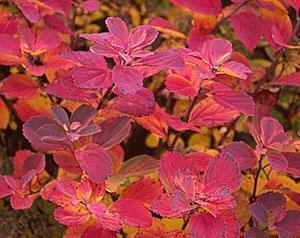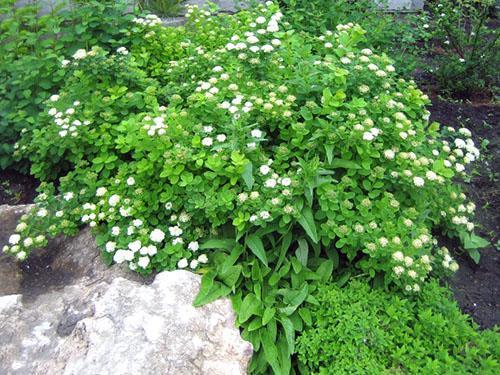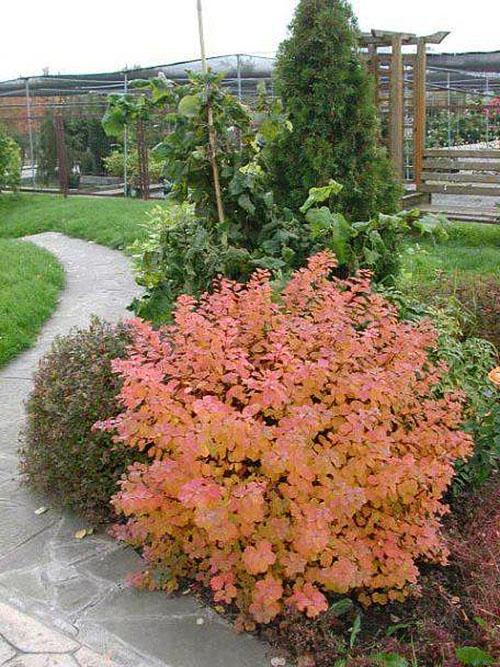Fall in love with a lush beauty spiraea birch leaf
 It seems that there is no free space on the site, but spring is coming, and again it is impossible to pass by plants, especially such as spirea. After all, this beauty is noticeable from afar. She attracts with her colors, tenderness and accuracy.
It seems that there is no free space on the site, but spring is coming, and again it is impossible to pass by plants, especially such as spirea. After all, this beauty is noticeable from afar. She attracts with her colors, tenderness and accuracy.
What a miracle is growing in the yard

Plant forms are varied. It is impossible to list everything, but here are some of them:
- similar to a pyramid;
- resemble a hemisphere;
- upright;
- have the form of a cascade;
- spread along the ground;
- weeping and others.
 The height of the spirea does not exceed two meters. A plant of one species differs from a plant of another only in the shape and color of the leaves. Most varieties change their color by autumn. Green leaves turn purplish red, yellow, or orange. As you can see in the photo, the spirea in the garden design is its real decoration. And if you still correctly select and plant several types of this plant on the site, then it will delight you with its flowering from spring to late autumn.
The height of the spirea does not exceed two meters. A plant of one species differs from a plant of another only in the shape and color of the leaves. Most varieties change their color by autumn. Green leaves turn purplish red, yellow, or orange. As you can see in the photo, the spirea in the garden design is its real decoration. And if you still correctly select and plant several types of this plant on the site, then it will delight you with its flowering from spring to late autumn.
 The flowers of the spirea are small, but their number is huge and they combine into inflorescences of different shapes:
The flowers of the spirea are small, but their number is huge and they combine into inflorescences of different shapes:
- paniculate;
- spike-shaped;
- corymbose;
- pyramidal;
- single.
The color of the flowers can be pure white and gradually turn into crimson.
Division into groups
 In order to ensure the correct planting and care of the birch spirea, you should know which group it belongs to.
In order to ensure the correct planting and care of the birch spirea, you should know which group it belongs to.
According to the location of the place of formation of flowers, the plant is divided into two groups:
- The first includes bushes that bloom in May - early June. Flower buds are formed along the entire length of the last shoot.
- The second is the plants that bloom in July - August. On these bushes, flower buds are formed on the shoots of the current year. It is to this group that the birch spirea plant belongs. Further, we will talk about it in more detail.
Landing
 This bush is planted in a pure or mixed manner with other plant species. It is also suitable for creating a hedge with higher bushes, and for rockeries.
This bush is planted in a pure or mixed manner with other plant species. It is also suitable for creating a hedge with higher bushes, and for rockeries.
In a hedge, the distance between the spireas should be fifty centimeters, and between the rows forty. If they are arranged in groups, then it is desirable that the plants be at a distance of about seventy centimeters from each other. Bushes are planted in September, most often in cloudy and rainy weather. The planting pit should exceed the root size by thirty percent. The planting depth is fifty centimeters, the root collar is at ground level. Drainage from sand and broken brick is required.
Shrub pruning
 Every year in early spring, as soon as the plant has roused itself from winter sleep, pruning should be carried out. This is done like this:
Every year in early spring, as soon as the plant has roused itself from winter sleep, pruning should be carried out. This is done like this:
- the shoot is shortened to developed buds;
- the smallest shoots are removed completely.
After correct pruning, powerful shoots are formed. If you do not remove the shoots, then from the fourth year the top of the bush begins to gradually dry out. The stem of birch spirea lives for about seven years, but thanks to the formation of root shoots, the plant can be considered durable.After four years of life, the top of the bush should be trimmed every year at a distance of thirty centimeters from the ground.
If even after pruning, weak growth develops and flowering is not pleasing to the eye, get rid of this plant, replace it with a younger one. Usually, such a procedure for Spirea birch-leaved "Top" is carried out after fifteen, twenty years.
To prevent the bushes from depleting during the formation of seeds, all faded inflorescences should be removed.
Reproduction and care
 There are several ways to reproduce spirea:
There are several ways to reproduce spirea:
- seeds;
- cuttings (spring and summer);
- layering.
Seeds are sown in spring. The soil mixes with the foliage, or best if it is aerated high-moor peat. They immediately sow in boxes, the soil must be well moistened. Mulches with a thin layer of peat or earth.
Nowadays, most often propagation occurs by cuttings.
When using this method, high humidity must be ensured.
When propagating by layering, it is worth remembering that the branches, thanks to which a new bush will appear in the spring, should be covered with leaves for the winter. Only if the correct planting and care of the birch spirea is ensured, one can hope to get a beautiful, intensely flowering plant.
Don't forget to feed the bush. In the spring, immediately after pruning, try to fertilize the soil, and somewhere closer to mid-June, the plant itself should be nourished. Fertilizer is prepared as follows:
- take five buckets of water;
- one bucket of fresh manure is added;
- for one bucket of the resulting solution, add five grams superphosphate.
Now about how Spirea birch-leaved "Top" relates to the winter cold. It is frost-resistant, does not need shelter. The best planting sites are sunny, the soil should be well-drained with a lot of organic matter.
The plant does not tolerate drought, it begins to disappear. Water it in moderation. On hot summer days, fifteen liters of water under a bush once every two weeks will be quite enough. When compacting the soil, be sure to loosen it and do not forget to weed the plant systematically.